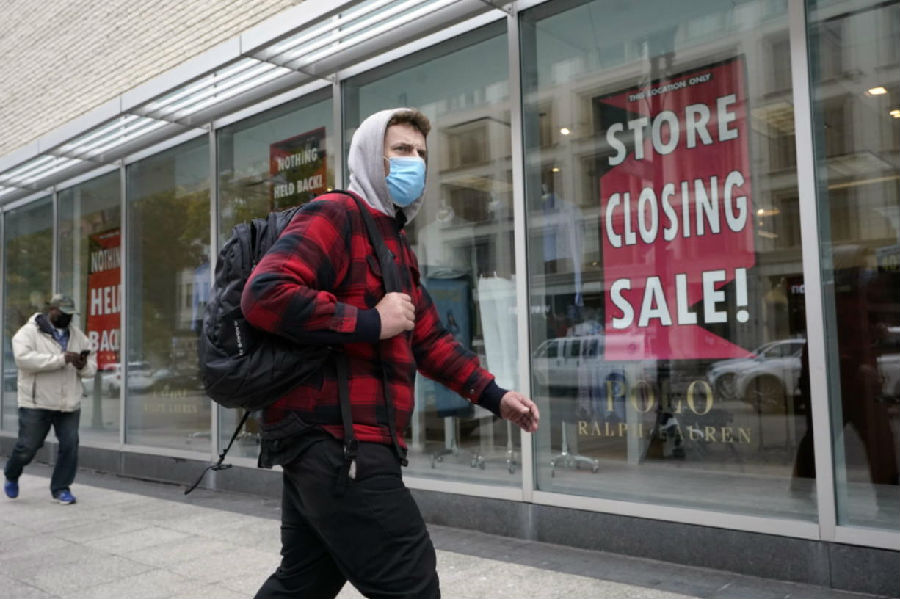United States
美国版块
The economy
经济
You must believe in spring
相信春天
The economic recovery no longer looks indestructible. A difficult winter looms
经济复苏的态势看起来不再坚不可摧。艰难的寒冬即将来临
In the summer and autumn America’s economy roared back. After peaking at nearly 15% of the labour force, unemployment fell like a stone, while in the third quarter GDP bounced from its lockdowninduced slump. The recovery of the world’s largest economy seemed oddly impervious to a second and then a third wave of coronavirus infections, even as economic activity in other parts of the world took a hit.
夏秋两季,美国经济复苏。美国劳动力的失业率在达到近15%的峰值之后一落千丈。美国第三季度的国内生产总值从封锁引发的衰退中反弹。奇怪的是,尽管世界其他地区的经济活动受到打击,但美国这个世界最大的经济体的复苏似乎丝毫没有受到第二波、第三波冠状病毒感染的影响。
Yet there are growing concerns that the run of surprisingly good economic news is over, at least until a vaccine becomes widely available. In congressional testimony on December 1st Jerome Powell, the chairman of the Federal Reserve, said the recovery was slowing, while the decision on the same day by a bipartisan group of senators to release a proposal for a stimulus package reflects the same fears. The jobs report for November, which was to be released shortly after The Economist went to press, will probably be a downbeat one by recent standards— and whatever it shows, it is old news, since the surveys for the report were taken some weeks ago. More up-to-date figures show that the recovery has lost steam. That is bad news for the millions who remain out of work, as well as the rapidly growing share of Americans who are living in poverty.
然而,越来越多的人担心,一连串出人意料的经济利好消息已经结束,至少在疫苗普及之前。12月1日,美国联邦储备委员会主席杰罗姆•鲍威尔在国会作证时表示,经济复苏正在放缓,而美国参议员两党小组在同日公布一项刺激方案的决定也反映了同样的担忧。《经济学人》付印后不久即将发布的11月就业报告,按照最近的标准来看,可能会是一份悲观的报告。不管就业报告的内容是什么,都势必会是旧消息,因为该报告的调查是在几周前进行的。更多最新数据显示,经济复苏已失去动力。这对数百万失业者来说是个坏消息,对急速增多的贫困美国人来说也是个坏消息。

Official statistics tend to be produced with long lags. So during the pandemic economists have turned to “high-frequency” data, largely produced by the private sector and generated by consumers’ and firms’ transactions, to measure the economy in real time. Wall Street banks now routinely provide clients with updates on everything from weekly electricity consumption to daily hotel bookings. The high-frequency data do not map onto the official kind perfectly. But they are useful for finding turning-points. They pinpointed the start of the downturn in March long before the official statistics could.
官方统计数据往往滞后太久。因此,在大流行期间,经济学家们转向了“高频”数据,这些数据主要由私营企业发出,由消费者和企业的交易产生,用来实时衡量经济。华尔街银行目前定期向客户提供所有最新消息,从每周用电量到每日酒店预订。高频数据并不能完美地映射到官方数据。但高频数据有助于寻找转折点。他们早在官方统计数据公布很久之前就确定了三月经济衰退的开始时间。
America is at another turning-point. STR, a data provider, finds that in the week ending November 21st hotels were running at 40% occupancy, down from 50% only weeks ago. The number of diners in restaurants has sharply declined in recent weeks, suggest data from OpenTable, a booking platform, with the fall even steeper in the states hardest hit by the virus. A recovery in air-passenger numbers appears to have ground to a halt as well.
美国正处于另一个转折点。数据提供方英国信达集团发现,在截至11月21日的一周内,酒店的入住率为40%,低于几周前的50%。订餐平台OpenTable的数据显示,近几周来,餐馆就餐人数急剧下降,受病毒影响最严重的州的下降幅度更大。航空客运人数的回升似乎也已陷入停顿。
译文由可可原创,仅供学习交流使用,未经许可请勿转载。













